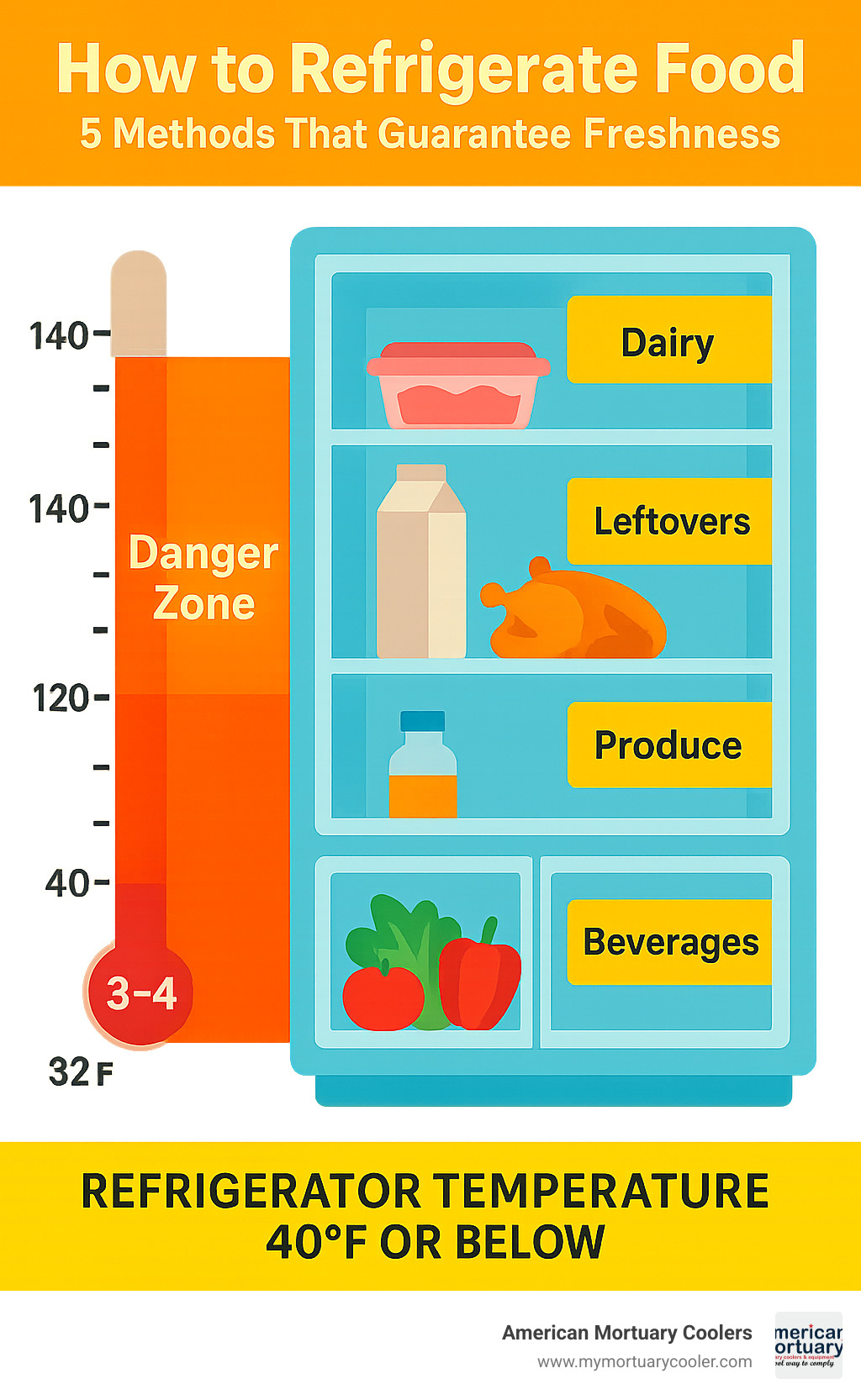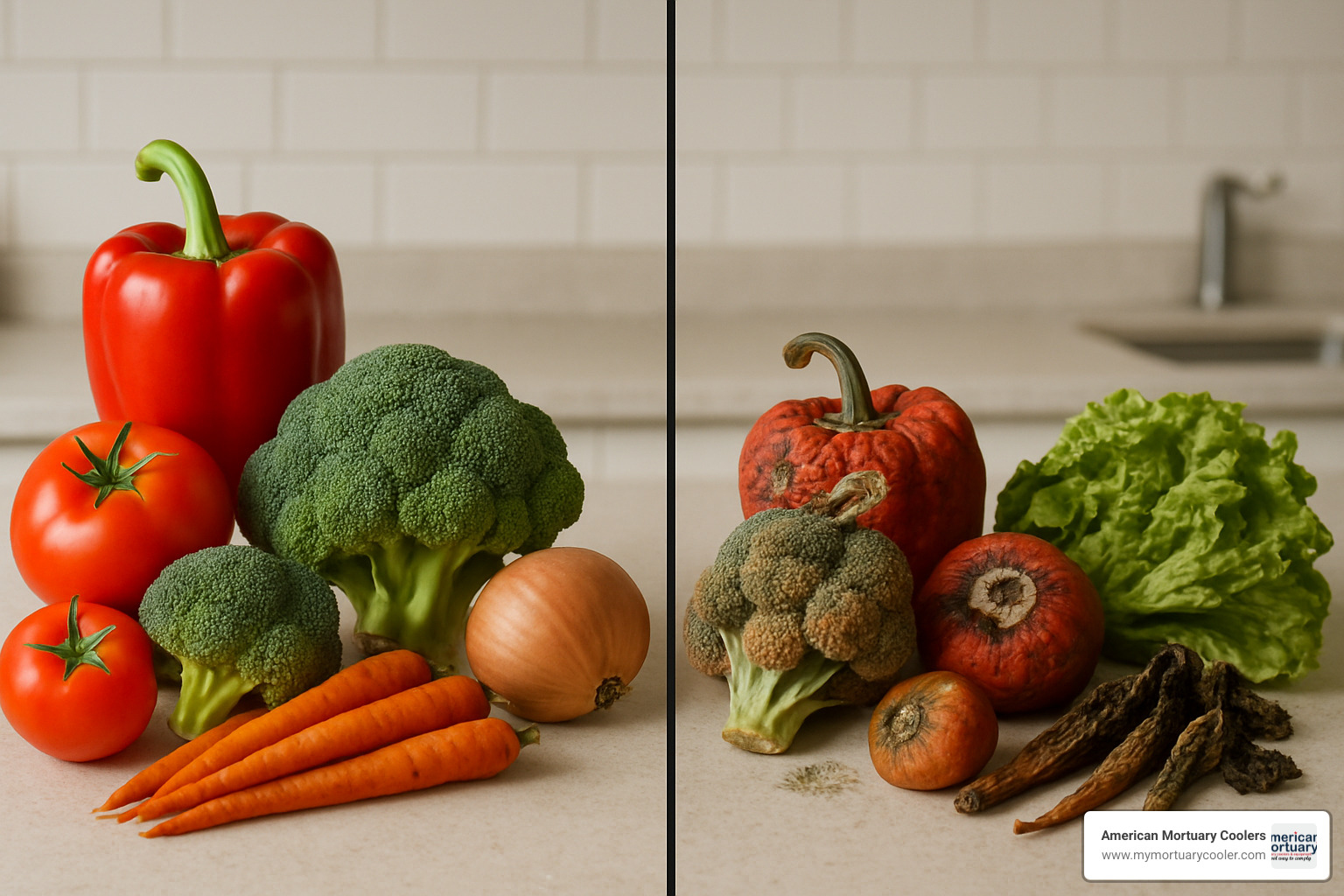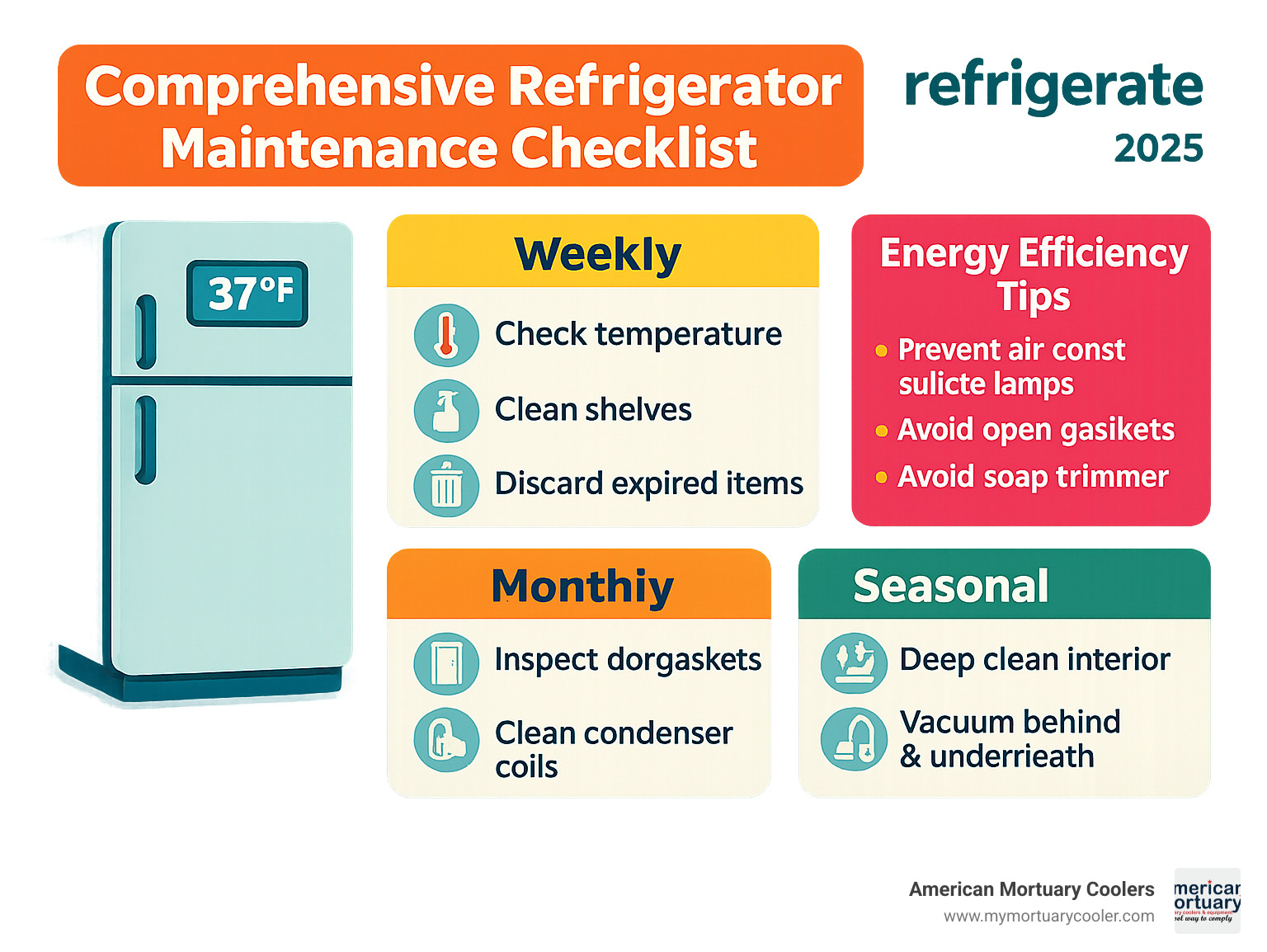
How to Refrigerate Food: 5 Methods That Guarantee Freshness
Why Food Safety Depends on How You Refrigerate
Refrigerate means to make or keep food cold at temperatures of 40°F (4°C) or below to slow harmful bacteria growth and preserve freshness. Here's what you need to know:
Essential Refrigeration Facts:
- Temperature: Keep refrigerators at 40°F or below, freezers at 0°F
- Time Limit: Never leave perishable foods at room temperature more than 2 hours (1 hour if above 90°F)
- Storage Duration: Use refrigerated leftovers within 3-5 days
- Safety Rule: When in doubt, throw it out
The word "refrigerate" comes from the Latin refrigeratus, meaning "to cool," and was first used in 1534. Today, proper refrigeration prevents foodborne illnesses caused by dangerous bacteria like Salmonella, E. coli, and Listeria that multiply rapidly in the "danger zone" between 40°F and 140°F.
High temperatures and humidity can stress your refrigeration system and affect stored product quality. Whether you're storing fresh produce, cooked leftovers, or dairy products, understanding the five core methods of refrigeration will help you maintain food safety and reduce waste.
I'm Mortuary Cooler, a national-level mortuary cooler supplier with extensive experience helping facilities maintain proper cold storage temperatures to refrigerate sensitive materials safely. My background in commercial refrigeration systems gives me deep insight into the science behind effective cooling methods.

Basic refrigerate vocab:
Why Refrigeration Matters: Safety, Etymology & Key Numbers
When you refrigerate food properly, you're doing something incredibly important—you're protecting your family from dangerous bacteria that could make them seriously ill. But here's what many people don't realize: there are actually two types of bacteria at work in your food.
Pathogenic bacteria like Salmonella, E. coli O157:H7, and Clostridium botulinum are the dangerous ones. These sneaky microbes can make you sick even when your food looks, smells, and tastes perfectly normal. Then there are spoilage bacteria, which are actually doing you a favor—they make food look gross, smell bad, or taste awful, giving you clear warning signs.
The magic number 40°F (4°C) isn't just some random temperature food scientists picked out of a hat. Scientific research on safe storage proves that harmful bacteria multiply like crazy between 40°F and 140°F. Food safety experts call this the "danger zone" for good reason.
Here's the thing about refrigeration temperatures: they slow bacterial growth dramatically, but they don't stop it completely. Listeria monocytogenes is particularly stubborn—it can still grow slowly even in your properly chilled fridge. That's why timing and proper handling matter just as much as temperature.
The two-hour rule is your safety lifeline. Never leave raw meat, poultry, eggs, cooked food, or cut fruits and vegetables sitting at room temperature for more than two hours. If it's hotter than 90°F outside, cut that time to just one hour. This isn't a suggestion—it's a hard rule that can prevent serious foodborne illness.
How 'refrigerate' Became a Household Verb
The word "refrigerate" has quite a journey behind it. It comes from the Latin refrigeratus, combining re- (meaning "again") with frigerare (meaning "to cool"). People first started using this word way back in 1534—long before anyone had ever seen an electric refrigerator.
Back then, folks relied on ice houses, root cellars, and other clever natural cooling methods to keep food fresh. As technology evolved and home refrigerators became common in the mid-20th century, "refrigerate" transformed from a fancy Latin term into an everyday household verb that we all use without thinking twice.
The Science Behind Cooling
When you refrigerate food, you're actually fighting two battles at once: slowing down microbial growth and controlling enzymatic changes. Both of these processes cause food to spoil, but cold temperatures affect them differently.
Most pathogenic bacteria basically go dormant when you chill them properly. But Listeria is the troublemaker of the bunch—it can still multiply slowly even at proper refrigeration temperatures. This is exactly why you can't just throw food in the fridge and forget about it.
Humidity plays a bigger role than most people realize. Your leafy greens need high humidity to stay crisp and fresh, while cheese actually prefers controlled moisture levels to prevent mold growth. And here's something that might surprise you: fruits like apples release ethylene gas that speeds up ripening in nearby produce. That's why proper storage separation isn't just about organization—it's about keeping your food fresh longer.
Understanding these scientific principles helps explain why simply keeping food cold isn't enough. You need the right temperature, proper timing, and smart storage strategies working together.
The 5 Methods That Guarantee Freshness

Think of food safety like a chain—it's only as strong as its weakest link. These five methods work together to create an unbreakable cold chain that keeps your food fresh and your family safe. Miss one step, and you're gambling with foodborne illness.
The beauty of this system lies in how each method reinforces the others. Perfect temperatures mean nothing without proper timing. Smart organization fails without good labeling. Master all five, and you'll slash food waste while protecting everyone at your table.
Method 1: Dial In the Right Temperatures
Your refrigerate success starts with getting the numbers right. Your fridge needs to stay at 40°F (4°C) or below, while your freezer should hit 0°F (-18°C). These aren't loose guidelines—they're non-negotiable safety requirements based on decades of food science.
Here's the thing: don't trust that digital display on your appliance door. Those built-in readings can be off by several degrees, which is enough to land you in the danger zone. Grab a couple of appliance thermometers instead. Stick one in your main fridge compartment and another in the freezer.
Check those readings every week. If your fridge is running at 45°F instead of 38°F, you've just cut your food safety margin in half. Every single degree matters when you're trying to slow bacterial growth.
| Appliance | Target Temperature | Purpose | Safety Note |
|---|---|---|---|
| Refrigerator | ≤40°F (4°C) | Slow bacterial growth | Check weekly with thermometer |
| Freezer | 0°F (-18°C) | Stop bacterial growth | Food safe indefinitely at 0°F |
Danger zone we talked about earlier? Between 40°F and 140°F, harmful bacteria throw a multiplication party. You don't want to be the host.
Method 2: Beat the Clock
Time is your enemy when it comes to food safety, but you can fight back with smart strategies. The two-hour rule isn't just a suggestion—it's your safety net. Any perishable food sitting at room temperature for more than two hours needs to go in the trash, not the fridge.
When you're dealing with hot leftovers, don't wait for them to cool down. That old advice about letting food reach room temperature first? Forget it. Your modern refrigerator can handle the heat without breaking a sweat.
Speed up the cooling process by dividing large batches into shallow containers. More surface area means faster heat escape. For soups and stews, try an ice bath—just nestle your container in a larger bowl filled with ice water and give it an occasional stir.
The faster you refrigerate those leftovers, the safer they'll be tomorrow.
Method 3: Zone Your Fridge for Produce & Protein
Your refrigerator isn't a democracy—some spots are definitely better than others. The coldest real estate is usually at the back of your lower shelves, while those door compartments get hit with warm air every time you open up.
Use this temperature geography to your advantage. TCS foods (that's time and temperature controlled for safety foods like raw meat, poultry, and seafood) get the VIP treatment in the coldest zones. Always store raw proteins on lower shelves so any drips don't contaminate your ready-to-eat foods below.
Those crisper drawers aren't just fancy storage—they're humidity control centers. High-humidity drawers keep your leafy greens from wilting, while low-humidity drawers prevent your apples from getting soggy.
Speaking of apples, here's a perfect example of why storage matters: whole apples can hang out on your counter for about a week, but they'll last several weeks in the fridge. Cut apples, however, need immediate refrigeration and should be eaten within two days. The moment you break that protective skin, the clock starts ticking.
This same principle applies across the produce aisle. Whole tomatoes are fine on the counter, but cut tomatoes need to refrigerate immediately to prevent cross-contamination and bacterial growth.
Method 4: Label, Date & Rotate
Those little phrases on food packages aren't just decoration. "Refrigerate after opening" and "refrigerate until opened" tell completely different stories. Items that need refrigeration before opening are fighting a safety battle—they need that cold environment to stay safe. Once you crack open shelf-stable items, many suddenly join the refrigeration club to prevent spoilage.
Date everything that goes into your fridge, especially leftovers. Most leftovers should get eaten within 3-5 days, though this varies by food type. Use the FIFO method—First In, First Out—to rotate your stock like a pro.
Here's where commercial operations really shine. More info about walk-in units shows how proper labeling and rotation systems can handle much larger volumes while maintaining the same safety principles.
When in doubt about whether something is still good, trust your senses over the date. But remember—pathogenic bacteria don't always announce themselves with obvious signs.
Method 5: Freeze for the Long Game
Freezing is like hitting the pause button on time itself. At 0°F (-18°C), bacterial growth stops completely, making properly frozen food safe indefinitely. That's right—forever safe, though quality is another story.
Freezer burn might look scary with those white or grayish spots, but it's purely a quality issue, not a safety concern. It happens when moisture escapes and air sneaks in. Fight back with airtight packaging—vacuum-sealed bags, freezer-grade containers, or heavy-duty freezer wrap.
Label your frozen items with both contents and date. While that chicken will be safe to eat five years from now, it probably won't taste very good. Most frozen foods hit their quality peak within 3-12 months, depending on what you're storing.
The freezer is your secret weapon against food waste, but only if you use it strategically.
Smart Storage Strategies & Common Pitfits

Even with the five core methods mastered, smart storage requires understanding the quirks and exceptions that catch most people off guard. These strategies can make the difference between food that stays fresh for days versus food that spoils overnight.
Humidity drawers are your secret weapon for produce storage, but they only work if you use them correctly. Set the high humidity drawer for leafy greens, herbs, and broccoli—these vegetables need moisture to stay crisp. The low humidity drawer works best for apples, pears, and stone fruits that release ethylene gas as they ripen.
The tomato myth deserves clarification because it's more nuanced than most people realize. Whole, ripe tomatoes do lose some flavor when you refrigerate them, but unripe tomatoes handle cold storage just fine. Here's the key: cut tomatoes must always be refrigerated regardless of flavor considerations. Food safety trumps taste every time.
Infant formula breaks all the usual storage rules. While most "use-by" dates indicate quality, infant formula dates are about safety. This isn't negotiable—the vulnerability of babies means you must follow expiration dates exactly, and always refrigerate prepared formula immediately.
Don't forget about medications in your refrigeration planning. Many liquid medications, insulin, and biologics need consistent cold storage. Some specify "refrigerate until opened" while others require continuous refrigeration throughout their shelf life.
The signs of spoiled food aren't always obvious, especially with dangerous bacteria that don't change appearance. Trust your senses—odd odors, slimy textures, or unusual colors signal trouble. When something looks questionable, it's better to waste a few dollars than risk food poisoning.
Even pop culture recognizes refrigeration's importance. The Pokémon ability "Refrigerate" transforms Normal-type moves into Ice-type moves with increased power—a playful nod to how cooling can transform and preserve what matters most.
These storage strategies work whether you're managing a home kitchen or need commercial solutions for larger operations. The principles remain the same: control temperature, manage time, and stay vigilant for signs that your cold storage system needs attention.
Maintenance & FAQs in One Place

Keeping your refrigerator running smoothly isn't complicated, but it does require regular attention. Think of maintenance as insurance for your food safety and your wallet.
Gasket checks should happen monthly. Run your hand along the rubber door seals looking for cracks, tears, or areas that don't seal tightly. A simple test: close the door on a dollar bill. If you can pull it out easily, the gasket needs attention. Poor seals let warm air in and cold air out, forcing your refrigerator to work harder and compromising its ability to refrigerate effectively.
Weekly cleaning prevents small problems from becoming big ones. Remove expired items first, then wipe down shelves with a mild soap solution. Don't forget to check that air vents aren't blocked by containers or produce bags. Good airflow keeps temperatures consistent throughout your refrigerator.
Keep appliance logs if you're serious about food safety. Write down weekly temperature readings and note any unusual occurrences. This becomes especially important during power outages or when your refrigerator starts acting up.
Speaking of power outages, have a plan ready. Keep refrigerator and freezer doors closed during outages. A closed refrigerator stays cold for about 4 hours, while a full freezer can maintain safe temperatures for 48 hours. When power returns, use a thermometer to check internal temperatures. Discard any perishables that stayed above 40°F for more than 4 hours.
At American Mortuary Coolers, we've seen what happens when refrigeration systems fail. Our experience with commercial cooling systems across Tennessee and nationwide has taught us that regular maintenance prevents costly breakdowns and keeps systems running when you need them most. More info about morgue freezers shows how critical proper maintenance becomes in professional settings.
Frequently Asked Questions about refrigerate
These questions come up constantly, whether you're managing a home kitchen or a commercial facility. The principles remain the same: temperature control, timing, and common sense.
What is the safest way to cool leftovers quickly?
The ice bath method works best for rapid cooling. Place your container of hot food in a larger bowl filled with ice water. Stir occasionally to help heat escape faster. This can cool soup or stew in minutes instead of hours.
Shallow containers speed cooling too. Divide large batches into smaller, shallow pans to increase surface area. A thick pot of chili might take 6 hours to cool safely, but the same chili in shallow containers cools in under 2 hours.
Don't worry about putting hot food directly in the refrigerator. Modern units can handle the heat load without raising internal temperatures dangerously.
How can I tell if refrigerated food has spoiled?
Your senses are your best tools, but they're not foolproof. Look for color changes—meat turning gray or green, dairy products developing unusual hues. Check texture by touching foods. Slimy vegetables, separated sauces, or sticky surfaces where they shouldn't be all signal spoilage.
Odor often provides the clearest warning. Sour smells from normally mild foods, rancid or chemical odors, or just "off" smells mean it's time to toss the item.
Remember though, dangerous bacteria like Salmonella don't always announce themselves with obvious signs. When you're unsure, trust the old rule: when in doubt, throw it out.
What should I do if I'm unsure a food needs refrigeration?
Check the label first. Manufacturers test their products and provide storage instructions based on safety data. Look for phrases like "keep refrigerated" or "refrigerate after opening."
When labels aren't helpful, consult the USDA FoodKeeper app or website. This free resource provides authoritative guidance on storage requirements for hundreds of foods.
As a general rule, refrigerate anything that's moist, high in protein, and low in acid. Cooked rice, cut melons, egg salad, and cream-based sauces all need cold storage, even when it's not immediately obvious why.
Conclusion
Taking care of your food through proper refrigeration doesn't have to be rocket science, but it does make a real difference in keeping your family safe and your grocery budget intact. When you refrigerate correctly, you're doing so much more than just keeping things cold—you're creating a shield against foodborne illness and throwing away less food at the end of the week.
The foundation starts with getting your temperatures right. Set your refrigerator to 40°F or below and your freezer to 0°F, then double-check those numbers with actual thermometers. Don't trust the digital display alone—we've seen too many cases where the readout says one thing while the actual temperature tells a different story.
The five methods we've covered work best when you use them together. Control your temperatures religiously, manage your timing with the two-hour rule, organize your fridge zones thoughtfully, stay on top of labeling and rotation, and accept freezing for the long haul. Each method strengthens the others, creating a system that practically runs itself once you get into the rhythm.
Your refrigerator layout matters more than most people realize. Keep those high-risk foods like raw meat and dairy in the coldest spots, use your humidity drawers the way they were designed, and remember that cross-contamination prevention is just as important as temperature control. A little planning goes a long way.
Regular maintenance keeps everything running smoothly. Clean up spills quickly, check those door seals monthly, and don't let clutter block your air vents. These small habits prevent bigger problems down the road and keep your energy bills reasonable too.
At American Mortuary Coolers, we've learned that precision in temperature control becomes absolutely critical in specialized applications. More info about morgue freezers shows how these same principles scale up when there's no room for error. Whether you're storing leftovers or managing commercial refrigeration, the fundamentals remain the same.
The bottom line is simple: when you refrigerate properly, everyone wins. Your food stays safer longer, your family stays healthier, and your wallet stays happier. These aren't complicated techniques—they're just good habits that become second nature with a little practice.



